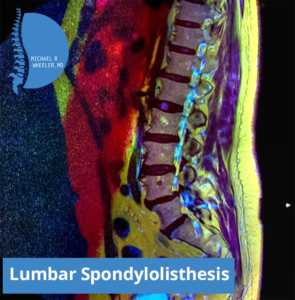What is lumbar spondylolisthesis?
Lumbar spondylolisthesis occurs when one vertebra slips forward on another vertebra. The most common level this occurs is L4-5 or L5-S1, but lumbar spondylolisthesis can occur at any level of the lumbar spine. Sometimes I will refer to this condition as a sliding spine. There are many causes of spondylolisthesis, however, the most common cause is degenerative wear and tear.
Spondylolisthesis is categorized as either stable or unstable. Stable spondylolisthesis means the spine is slipped, but it does not have a lot of motion between the affected bones. Unstable spondylolisthesis means as the patient flexes and extends the lumbar spine, the bones will slip backward and forward on each other.
What symptoms does lumbar spondylolisthesis cause?
 The most common symptoms caused by lumbar spondylolisthesis is lower back pain. Patients often also have pain in the hips or legs. Lumbar spondylolisthesis can cause narrowing of the spinal canal where the nerves should float freely, causing spinal stenosis. This stenosis can cause leg pain, burning, tingling, numbness, weakness or combination of the above. Not all patients who have spondylolisthesis have symptoms.
The most common symptoms caused by lumbar spondylolisthesis is lower back pain. Patients often also have pain in the hips or legs. Lumbar spondylolisthesis can cause narrowing of the spinal canal where the nerves should float freely, causing spinal stenosis. This stenosis can cause leg pain, burning, tingling, numbness, weakness or combination of the above. Not all patients who have spondylolisthesis have symptoms.
How is lumbar spondylolisthesis diagnosed?
Lumbar spondylolisthesis is most easily identified on x-ray of the lumbar spine while in the standing position. It can also be apparent on CT scan or MRI. Most of the time, an x-ray is all that is needed to diagnose lumbar spondylolisthesis. Additional imaging is sometimes utilized to better define the bony anatomy or evaluate the individual nerves.
How is lumbar spondylolisthesis treated?
A cornerstone treatment for any patient with symptomatic lumbar spondylolisthesis is core strengthening and flexibility. By strengthening the muscles of the core, it limits how much stress is placed on the slipped vertebra. A good exercise program is a fundamental pillar of treatment for lumbar spondylolisthesis. For patients that do not respond to physical therapy exercise programs and anti-inflammatory medications, sometimes interventional pain procedures can be performed. This may include facet injections, medial branch blocks, or epidural steroid injections.
For patients that continue to have symptoms despite conservative management, surgical discussion is warranted. The treatment of symptomatic lumbar spondylolisthesis is stabilizing the vertebra with some form of fusion. There are different types of fusions that can be performed for this procedure. Two common fusion procedures are the anterior lumbar interbody fusion and lateral lumbar interbody fusion.



